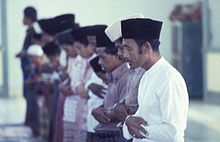Taqiyah (cap)
| Part of a series on |
| Islamic culture |
|---|
| Architecture |
| Art |
| Clothing |
| Holidays |
|
| Literature |
| Music |
|
Theatre |

The Taqiyah (
In
Etymology
Taqiyah is the
Muslim world
There are a wide variety of Muslim caps worn around the world. Each country or region usually has a unique head covering.
By country
Afghanistan
In Afghanistan men wear all sorts of araqchin, with different designs depending on the wearer's ethnicity, village and affiliations. They often wrap a turban around it, which is usually white, but black and other colors are also widely seen. They wear their araqchins with a peran tomban or perahan wa tonban, which means 'shirt and trousers' in the Persian of Afghanistan, which corresponds to a different, more archaic version of the shalwar kameez, being collarless, and of a wider cut. Traditionally the shirts sport distinctive embroidery, sometimes golden. But due to war, the traditional peran tomban is less and less used, and the shalwar kameez with a collar is becoming more and more used, specially by Eastern Afghans, and people coming from poor backgrounds.[citation needed]
Maldives
The prayer cap is called thakiha. The cap is known as the thofi and the fisherman's cap is referred to as koari.[citation needed]
Bangladesh

The prayer cap in Bangladesh is known as a ṭopi, from the
The Indian topi worn by Muslim men in Bangladesh and South Asia should not be confused with the Dhaka topi, which is worn by men in Nepal.[citation needed]
Pakistan
The prayer cap is called a topi. Pakistani men wear a variety of other caps including the Sindhi topi, a mirrored cap with a front opening that allows the wearer to place the forehead on the ground during prayer. Other caps include the karakul (hat), fez (hat) and pakol.[citation needed]
Russia
Muslim men wear the
Somalia

Men in Somalia often wear the koofiyad cotton prayer cap, along with a sarong referred to as a macawiis. The jalabiya is also sometimes worn.[8]
Sudan
The prayer cap is worn under a white
Turkey
Before 1925, men used to wear the
Turkmenistan

In Turkmenistan taqiyahs are called tahýa in the Turkmen language and are a Turkmen national headdress with embroidered national patterns. The tahýa is an indispensable item of the national male garment, often worn on daily basis, along with another traditional headgear, the telpek, a sheepskin hat.[9]
In ancient times, Turkmens believed that the tahýa protects the owner from the evil eye and other troubles. Also, custom prohibited transferring an old tahýa to another person or throwing it away. In everyday life, the tahýa was intended to protect the head from the sun. Tahýa shapes can be oval, round, high and low. They are sewn from different fabrics such as velvet, silk, satin and chintz. Where girls' tahýas were softer and decorated with different colorful patterns, men's tahýas had restrained, simple patterns. Men put the tahýa on their shaved heads.[citation needed]
Among
United Arab Emirates
Men in the UAE often wear the gahfiyyah cotton prayer cap.
By region
Central Asia



The
Southeast Asia

In
Traditional Malaysian men's attire consists of a shirt, matching pants, and waist wrap that is called a
Balkans
Africa
The
In East Africa, the kofia is commonly worn in the Muslim communities in the coastal areas of Kenya, Tanzania, and Uganda. Some Swahili speaking populations that are Muslim wear the kofia with a white robe called a kanzu in the Swahili language. In the United States, the kanzu is sold as an Omani thobe, Emirati thobe, or Yemeni dishdasha. A white kanzu and suit jacket or blazer is the formal wear of Swahili peoples.[citation needed]
In West Africa, there is the
The traditional women's attire is the wrapper, with hijab (worn as a turban or turban with additional scarf covering the sides of the head.[citation needed]
See also
- Kufi
- Dhaka topi
- Plis
- Fez (headdress worn in the Middle East and Balkans)
- Islamic clothing
- Kalimavkion
- Keffiyeh (headdress worn in the Middle East)
- Kippah (skullcap worn by Jews)
- Klobuk
- Kufi (cap worn by male in Africa)
- List of hats
- Pakol
- Religious clothing
- Sindhi cap
- Skufia
- Tubeteika (cap worn in Central Asia)
- Zucchetto (skullcap worn by clerics of Catholic churches)
Notes
Explanatory notes
Citations
- PMID 37868539.
- ISBN 978-1-60938-535-4.
- ^ Osbourne, Eileen (2005). RE - Buildings, Places, and Artefacts A Teacher Book + Student Book (SEN) (11-14). Folens Limited.
- ISBN 978-1-3984-5078-3.
- ISBN 978-1-4473-6361-3.
- PMID 37868539.
- ISBN 979-8-216-06994-2.
- ^ Michigan State University. Northeast African Studies Committee, Northeast African Studies, Volume 8, (African Studies Center, Michigan State University: 2001), p.66.
- ^ Wood, Andrew (2021). A Rhetoric of Ruins: Exploring Landscapes of Abandoned Modernity. Rowman & Littlefield. p. 158.

